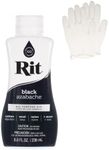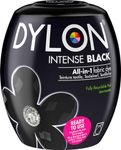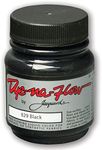Buying Guide for the Best Black Fabric Dye
Choosing the right black fabric dye can be a bit overwhelming, but with the right knowledge, you can find the perfect product for your needs. The key is to understand the different specifications and how they affect the dyeing process and the final result. By considering factors such as dye type, fabric compatibility, ease of use, colorfastness, and environmental impact, you can make an informed decision that will give you the best results for your project.Dye TypeDye type refers to the chemical composition of the dye and how it interacts with the fabric. Common types include fiber reactive dyes, acid dyes, and all-purpose dyes. Fiber reactive dyes are ideal for natural fibers like cotton and linen, providing vibrant and long-lasting colors. Acid dyes work best on protein fibers such as wool and silk, offering rich hues. All-purpose dyes are versatile and can be used on a variety of fabrics, but may not provide as intense or durable results. Choose the dye type based on the fabric you are working with to ensure the best outcome.
Fabric CompatibilityFabric compatibility is crucial because not all dyes work well with all fabrics. Natural fibers like cotton, linen, wool, and silk generally take dye better than synthetic fibers like polyester and nylon. Some dyes are specifically formulated for synthetic fabrics, so it's important to check the label to ensure compatibility. If you're dyeing a blend of natural and synthetic fibers, look for a dye that is designed to work with both types. Understanding your fabric's composition will help you select a dye that will adhere properly and produce the desired color.
Ease of UseEase of use refers to how simple the dyeing process is, including preparation, application, and cleanup. Some dyes require multiple steps, such as pre-soaking the fabric in a fixative or using heat to set the color, while others are more straightforward and can be used directly in the washing machine. If you're new to dyeing or looking for a quick and easy project, consider a dye that has a simple application process. Reading user reviews and instructions can give you a good idea of how user-friendly a dye is.
ColorfastnessColorfastness is the dye's ability to resist fading or bleeding over time, especially when exposed to washing, sunlight, and wear. High-quality dyes are designed to be colorfast, ensuring that the color remains vibrant and doesn't transfer to other fabrics. If you need a dye for items that will be frequently washed or exposed to the elements, look for one that specifically mentions colorfast properties. Testing a small swatch of fabric before dyeing the entire piece can also help you gauge the colorfastness.
Environmental ImpactEnvironmental impact considers the ecological footprint of the dye, including the chemicals used and the waste produced during the dyeing process. Some dyes are made with eco-friendly ingredients and have minimal environmental impact, while others may contain harmful chemicals. If sustainability is important to you, look for dyes that are labeled as non-toxic, biodegradable, or environmentally friendly. Additionally, consider the water and energy usage required for the dyeing process, and opt for products that promote eco-conscious practices.













